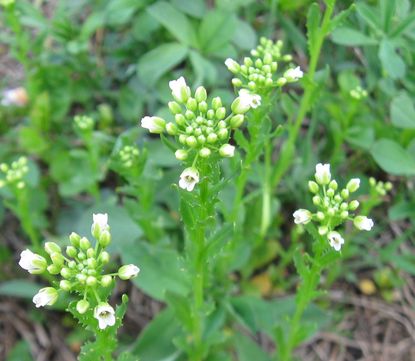Pennycress Weed Control – Tips On Managing Pennycress


Plants have been used for food, pest control, medicine, fibers, building material, and other purposes since humans became bipedal. What was once an angel can now be considered a devil in many species. Pennycress plants are an ideal example. Some of the more positive field pennycress facts reveal the plant has twice as much oil as soybeans, helps control some pests, and reduces nitrogen run-off. Yet, they are branded a weed by many farmers and have an invasiveness rank of 42 out of 100 from the Alaska Natural Heritage Program. If the plant is not useful to you and is invading your land, learn how to control field pennycress by first identifying the plant and then choosing your treatment.
Field Pennycress Facts
Field pennycress (Thlaspi arvense) is native to Europe and has been transplanted to North America. In most states it is not a weed of concern but is has invasive potential in disturbed areas. While many of us view the plant as a nuisance, farmers growing pennycress can effectively increase farm revenues by 25 to 30% by growing the herb as an overwinter crop. However, the seeds can produce gastric problems when eaten by cattle and it has the potential to spread rampantly from its seed. A single plant can produce 20,000 seeds in its annual cycle. Pennycress is a winter annual herb with simple to lobed leaves and tiny white flowers with four petals. It is a plant in the mustard family with a strong, unpleasant odor. The plant may be considered a weed in some areas of the United States but in the corn belt, it has potential as an off season crop. Biodeisel companies have developed considerable interest in the plant and many agrofarms are planting it between corn and soybean crops. Once oils have been extracted from the plants, the seed meal remaining can be processed into plane fuel, livestock feed, or protein additives for human consumption. These benefits may make farmers think twice about pennycress weed control.
Description of Pennycress Plants
Managing pennycress starts with recognizing the plant and its spread. The plant is 1 to 2 ½ inches (2.5-6 cm.) tall. They start out as a rosette that spans 6 inches (15 cm.) in diameter. The herbaceous leaves are oval to lance-shaped, simple, alternate, 1 to 4 inches (2.5-10 cm.) long and have distinct petioles. If allowed to grow, the plant produces one or more rigid, ribbed stems. Flowers are produced at the ends of these stems in white racemes in mid spring to late summer. These develop into coin sized, flat pods with numerous tiny seeds. The root system has a deep taproot, making managing pennycress by hand pulling challenging.
How to Control Field Pennycress
Pulling the plants manually has success in small areas as long as you use a spade to get out all the roots. There are no known biological controls. Mowing or tilling before the plant produces seed is also a viable option but difficult to do in cropland, as seeds mature before crops have developed to harvest. Pennycress weed control in agricultural situations is through the use of chemicals. Multiple herbicide applications are necessary for consistent pennycress weed control. Your local extension office can help with suitable types of effective herbicides. Note: Chemical control should only be used as a last resort, as organic approaches are safer and much more environmentally friendly.
Gardening tips, videos, info and more delivered right to your inbox!
Sign up for the Gardening Know How newsletter today and receive a free download of our most popular eBook "How to Grow Delicious Tomatoes."

Bonnie Grant is a professional landscaper with a Certification in Urban Gardening. She has been gardening and writing for 15 years. A former professional chef, she has a passion for edible landscaping.
-
 Grow a Bathroom Oasis: 8 Best Bathroom Plants With No Light or Low Light
Grow a Bathroom Oasis: 8 Best Bathroom Plants With No Light or Low LightSome apartment dwellers grow the best bathroom plants with no light or low light. Read how one of our favorite plant lovers does it in the big city.
By Teo Spengler
-
 "My Worst Mistake" – Gardeners Share 10 Hard-Learned Lessons
"My Worst Mistake" – Gardeners Share 10 Hard-Learned LessonsGardeners never stop learning, and sometimes our mistakes are the best teachers. But why not save time and heartache by learning from other gardeners' failures?
By Melanie Griffiths